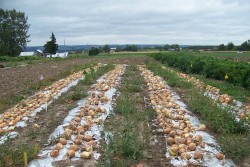Stop the Rot! - Using Cultural Practices to Manage Bacterial Diseases of Onion
Christy Hoepting, Extension Vegetable Specialist
Cornell Vegetable Program
April 2, 2012

Do you know how easy this is? A simple modification to adjust your planting configuration is all it would take to drastically reduce losses from bacterial bulb decay. Our studies showed that when plant spacing was reduced from 6 or 8 inches to 4 inches with 3 or 4 rows per 3-foot plastic mulch bed (row spacing: 4 rows = 6 inch; 3 rows = 8 inch), this provided 53 to 64% control of bacterial bulb decay at harvest (Table 1). Marketable yield also increased by 1.4 to 2.4 times, representing an increased net economic return of $43 to $258 per 100 feet of bed, due to increased weight of marketable jumbo-sized bulbs (Table 1). We learned that wide plant spacing produces big bushy plants with more leaves, thicker necks, delayed maturity and bigger bulbs. Unfortunately, it was these bigger bulbs that rotted! By narrowing plant spacing, we got fewer colossal-sized bulbs, which we more than made up for by having significantly more healthy jumbo-sized bulbs to market (Table 1).
Alternatives to black plastic reduced bacterial bulb decay by 59 to 75%
This is also a very simple and easy modification for small-scale growers producing onions on plastic mulch to make to their cultural practices that could go a very long way towards reducing bacterial bulb decay. Our studies showed that reflective silver mulch, biodegradable black plastic and bare ground had significantly 1.8 to 2.8 times higher marketable yield than black plastic (Table 2). Reflective silver and biodegradable black plastics had significantly 3.7 and 3.6 times, respectively, higher jumbo weight than black plastic, which resulted in an increased net return of $96 to $215 per 100 feet of bed compared to black plastic (Table 2). All of the alternatives to black plastic had significantly lower soil temperatures compared to the black plastic; we suspect that the higher temperatures of the black plastic are more favorable for development of bacterial diseases.
Stop the Rot article (pdf; 1356KB)













































